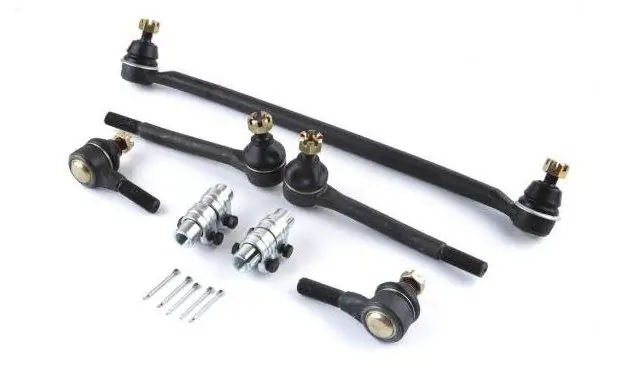2025 Author: Erin Ralphs | [email protected]. Last modified: 2025-01-22 21:14:09
The steering system is one of the most basic in a car. This is a set of mechanisms that synchronize the position of the steering wheel and the angle of rotation of the front steered wheels. The main function for any vehicle is to provide the ability to turn and maintain the direction set by the driver.
Device
Structurally, the steering of a car consists of a couple of main components. As for the mechanisms, they can be implemented in different ways.

The steering wheel is necessary for steering. The driver through it indicates the direction in which the car is moving. In modern cars, the steering wheel can be additionally equipped with keys and controls to control multimedia and navigation systems. If the driver replaces the multimedia system in the future, a steering adapter must be purchased to adjust the radio from the steering wheel. There is also a pillow inside the elementsecurity.
Next in the system is the steering column. What is it for? It is necessary to transfer the force that the driver applies to the steering wheel to the mechanism. The part is a shaft with a hinge. More often it is a small cardan. Often steering columns provide safety in case of theft. So, the design is equipped with mechanical or electrical blocking systems. Also on the column is the ignition switch, turn levers, turn on the lights, windshield wipers.

The steering mechanism receives force from the column shaft and then transforms it into turning the wheels. The design of the steering mechanism is a gearbox with a certain gear ratio.
The system also has a drive. This is a system of rods and tips that take the force from the shaft and then transfer it to the tips and the steering wheel system.
Even in most designs of steering systems there is an amplifier. Can be hydraulic or electric. It is necessary to increase the rotational forces that go from the steering wheel to the wheels. Additional elements can also be distinguished - these are shock absorbers or dampers, as well as various elementary systems.
Steering mechanisms: types
Depending on which gearbox is installed in a particular car, the steering mechanism can be rack and pinion, worm or screw. We will consider each of them separately.
Racket
This is a widely used device that mostmodern cars. The main element is the rack and gear. The latter is constantly engaged with the gear rack, and it is located on the steering shaft.

The principle of operation of this mechanism is as follows. When the steering wheel is turned, the gear rack moves to the left or right. Together with it, the tie rods move, which are connected to the tips, and those, in turn, to the steering knuckles. Thus, the wheels of the car can turn to the desired angle for the driver.
The rack and pinion mechanism is quite simple, while it is distinguished by high efficiency and rigidity. But for all its merits, the steering rack is very sensitive to loads, especially to shock loads from driving over bumps in the road. Also, due to its design, it is prone to vibrations. The steering rack is most often found on front-wheel drive cars, where the front suspension is of an independent type.
Worm
This steering mechanism is based on a globoid worm. This is a worm shaft with a variable diameter. It is connected to the steering shaft. Also included is a roller. A steering arm is installed on the roller shaft, which is mechanically connected to the steering rods.
During the rotation of the steering wheel, the roller rolls over the worm, thereby setting the steering arm in motion. The latter as a result moves the drive rods. Due to this, the steering wheels turn in the direction the driver needs.
This option is less susceptible to any loads, including shock. In addition, large swivel angles and bettermaneuverability for a car. But there are also disadvantages here. So, the worm gear is more complex in terms of manufacturing, and therefore more expensive. The mechanism requires many connections to function properly, requiring periodic and complex adjustments.
This design can be found on vehicles with increased cross-country performance, as well as with dependent suspension of a pair of steered wheels. Another mechanism is found on small trucks and buses. Worm steering was installed on VAZs of classic models.
Screw mechanism
The following elements are combined in this solution. This is a screw that is mounted on the steering shaft, a nut that moves along the screw, a gear rack on the nut, a sector connected to the rack, and also a bipod. The latter is located on the shaft of the gear sector. Of the features, a nut-screw connection can be distinguished. Here it is made using a large number of small balls. Balls can significantly reduce the friction force between moving parts and thereby reduce wear.

The principle of operation of the mechanism resembles the operation of a worm system. When the driver acts on the steering wheel, the shaft is set in motion, and with it the screw that moves the nut rotates. In this case, the balls move inside the mechanism. The nut, when exposed to the rack, moves the gear sector. The steering arm also moves along with the sector.
This steering is more efficient than worm gear. The system is installed onluxury cars, heavy trucks and various bus models.
Power steering
All of the above systems required some effort. To facilitate the operation of cars, as well as to ensure that driving brings emotions and good mood, engineers have created a device that allows you to drive a car with almost no effort. This device is called an amplifier. Today, most cars are equipped with such a system.
Distinguish between hydraulic, electric, hydroelectric power steering. Pneumatic mechanisms can also be distinguished.
Power steering
This is one of the structural elements of the control system. Here, when the steering wheel is turned, the main force is generated by a hydraulic drive.
The simplest amplifier is a pump driven by the crankshaft. This solution has a performance that is directly proportional to the engine speed. This is in line with the driving needs. If the speed is maximum, then minimum gain is required and vice versa.

This system works as follows. When driving straight ahead, the steering pump circulates hydraulic fluid. When the steering wheel is turned, the torsion bar is twisted. The process is accompanied by the rotation of the spool relative to the distributor sleeve. The channels open, and the liquid enters one of the cavities in the power cylinder. Liquid fromthe other cavity goes into the tank. The piston in the power mechanism moves the rail. The force is transmitted to the steering rods, which leads to the rotation of the steered wheels.

When turns are made at low speeds, the amplifier operates at maximum performance. Based on the signals from the sensors, the ECU increases the speed of the pump. The working fluid enters the cylinder of the power mechanism more intensively. This reduces the effort required to turn the steering wheel.
Electric booster: features
This type of steering device is more complicated. There are a lot of sensors here. The system consists of an electric motor and mechanical elements. The most common designs are with two gears, as well as with a parallel drive. This amplifier is often located in the same unit with the steering system mechanism.

When the driver turns the steering wheel, the torsion bar is twisted or unscrewed. This is measured by a sensor - the current torque and the angle of rotation are taken into account. The speed of movement is also taken into account. All these numbers are sent to the ECU, which calculates the required force. By changing the current strength, the force on the rail of the mechanism changes.
Conclusion
These are all the steering systems of modern cars that exist today. Perhaps engineers will come up with better solutions in the future. In the meantime, a power steering rack is sufficient.
Recommended:
Steering trapezoid: device, purpose. Vehicle steering

The steering trapezoid on the "seven" consists of tips and central thrust. This mechanism ensures smooth and synchronous turning of both front wheels. The forces applied by the driver to the steering wheel are transmitted through the column to the gearbox. The latter allows you to convert the movement using a worm gear and rotates the steering knuckles through the steering rods
Steering column switch. Removing the steering column switches

If the turn signal, glass cleaner, lights or wipers suddenly stop working on your car, most likely the reason is hidden in a malfunction of the steering column switch. It is quite possible to solve this problem without the help of specialists. How is the stalk switch for turns and wipers dismantled? You will find the answer to this question in our today's article
Steering rack "Renault Megan-2": features, device. Replacing the steering rack "Renault Megan-2"

Steering is a mechanism by which the car moves in the direction set by the driver. According to the owners of Renault Megan-2, repairing the steering rack is a rather time-consuming process: removal alone can take an hour. And the most problematic part, the sleeve, often breaks during dismantling and creates problems with its removal
The composition of the car first aid kit - a list of essentials and requirements

Car first-aid kits: what should be included in their composition according to the new legislation? Shelf life of first aid kits, composition according to GOST. General recommendations on the use of a car first aid kit and the first steps to provide assistance in the event of an accident. Where can I buy a first aid kit for a car and at what cost?
Steering technique: turning the steering wheel when turning. Creaking, crunching when turning the steering wheel, what do they mean

Few drivers think about, for example, how correctly they hold the steering wheel, considering this an unimportant nuance that does not affect the quality of driving; Or what should be the turn of the steering wheel when turning. In fact, there is a whole technique for handling the steering wheel

